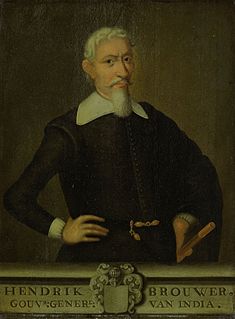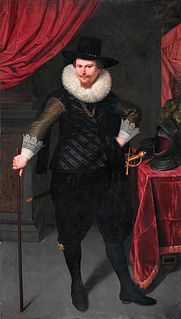| Pieter Both | |
|---|---|
Portrait of Pieter Both | |
| 1st Governor-General of the Dutch East Indies | |
| In office 19 December 1610 –6 November 1614 | |
| Preceded by | None |
| Succeeded by | Gerard Reynst |
| Personal details | |
| Born | 1568 Amersfoort, Spanish Netherlands |
| Died | 6 March 1615 Indian Ocean (near Mauritius) |
Pieter Both (1568 – 6 March 1615) was the first Governor-General of the Dutch East Indies.

The Governor-General of the Dutch East Indies represented Dutch rule in the Dutch East Indies between 1610 and Dutch recognition of the independence of Indonesia in 1949.
Not much is known of his early years. In 1599, Both was already an admiral in the New, or Brabant Company. In that year, he traveled to the East Indies with four ships. When the newly founded Dutch East India Company set up a government for the Dutch East Indies, Pieter Both was invited to become the Governor-General. He held that position from 19 December 1610 to 6 November 1614. During that period he concluded contracts with the Moluccans, conquered Timor, and drove the Spaniards out of Tidore.

The East Indies or the Indies are the lands of South and Southeast Asia. In a more restricted sense, the Indies can be used to refer to the islands of Southeast Asia, especially the Indonesian Archipelago and the Philippine Archipelago. The name "Indies" is derived from the River Indus and is used to connote parts of Asia that came under Indian cultural sphere.
The Dutch East India Company was an early megacorporation founded by a government-directed amalgamation of several rival Dutch trading companies (voorcompagnieën) in the early 17th century. It was established on March 20, 1602 as a chartered company to trade with India and Indianised Southeast Asian countries when the Dutch government granted it a 21-year monopoly on the Dutch spice trade. It has been often labelled a trading company or sometimes a shipping company. However, VOC was in fact a proto-conglomerate company, diversifying into multiple commercial and industrial activities such as international trade, shipbuilding, and both production and trade of East Indian spices, Formosan sugarcane, and South African wine.. The Company was a transcontinental employer and an early pioneer of outward foreign direct investment. The Company's investment projects helped raise the commercial and industrial potential of many underdeveloped or undeveloped regions of the world in the early modern period. In the early 1600s, by widely issuing bonds and shares of stock to the general public, VOC became the world's first formally-listed public company. In other words, it was the first corporation to be listed on an official stock exchange. It was influential in the rise of corporate-led globalisation in the early modern period.

The Dutch East Indies was a Dutch colony consisting of what is now Indonesia. It was formed from the nationalised colonies of the Dutch East India Company, which came under the administration of the Dutch government in 1800.
After he relinquished his position as Governor-General to Gerard Reynst, he left for the Netherlands with four ships. Two of the ships were shipwrecked in Mauritius at Flic-en-Flacq, and Pieter Both drowned.

Gerard Reynst was a Dutch merchant and later the second Governor-General of the Dutch East Indies.

The Netherlands is a country located mainly in Northwestern Europe. The European portion of the Netherlands consists of twelve separate provinces that border Germany to the east, Belgium to the south, and the North Sea to the northwest, with maritime borders in the North Sea with Belgium, Germany and the United Kingdom. Together with three island territories in the Caribbean Sea—Bonaire, Sint Eustatius and Saba— it forms a constituent country of the Kingdom of the Netherlands. The official language is Dutch, but a secondary official language in the province of Friesland is West Frisian.

Mauritius, officially the Republic of Mauritius, is an island nation in the Indian Ocean. The main Island of Mauritius is located about 2,000 kilometres (1,200 mi) off the southeast coast of the African continent. The Republic of Mauritius also includes the islands of Rodrigues, Agalega and St. Brandon. The capital and largest city Port Louis is located on the main island of Mauritius.
The second highest mountain of Mauritius is named Pieter Both after him.

Pieter Both is the second highest mountain of Mauritius, at 820 metres (2,690 ft) tall. The mountain is shorter than Piton de la Petite Rivière Noire by eight metres. It is named after Pieter Both, the first Governor-General of the Dutch East Indies. It is located in the Moka Range. The notable feature of this mountain is the gigantic rock formation at the very top of it, which resembles a human head. The palm species Hyophorbe amaricaulis, famous for being the world's rarest palm today, was once a common sight on this mountain.















